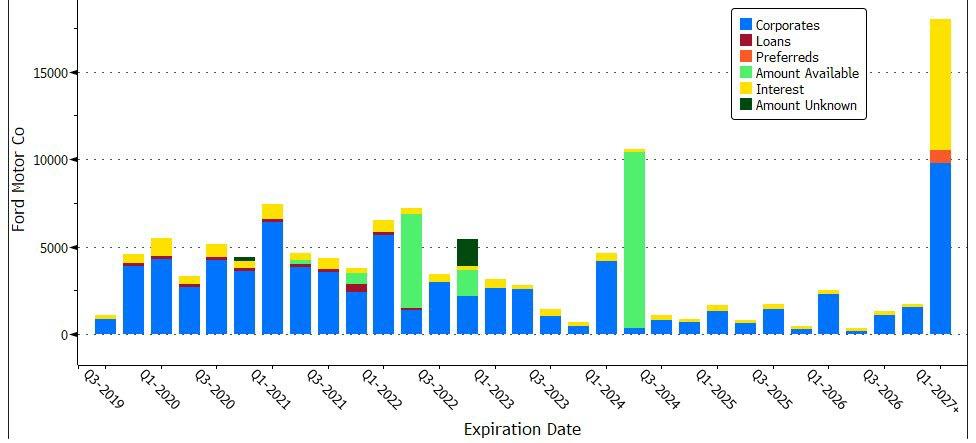Tumbling Angel: Moody’s Downgrades Ford, And Its $84 Billion In Debt, To Junk
With pundits warning for years about the threat of “fallen angels”, low-rated investment grade names downgraded to junk, the market first paid attention to, then learned to ignore the warnings as credit continued to tighten, helped in no small part by trillions in negative yielding sovereign debt – despite the ongoing threat of deteriorating fundamentals.
That however may now change as the universe of (split) junk bond names is about to become bigger by almost $100 billion after moments ago Moody’s downgraded Ford’s senior debt rating from investment grade Baa3 to junk Ba1 (stable outlook), in the biggest shot across the fallen angel bow in years.
According to Bloomberg, some $84 billion in debt is affected.
According to Moody’s, the Ba1 ratings reflect “the considerable operating and market challenges facing Ford, and the weak earnings and cash generation likely as the company pursues a lengthy and costly restructuring plan. The restructuring is expected to extend for several years with $11 billion in charges, and a cash cost of approximately $7 billion. Ford is undertaking this restructuring from a weak position as measures of cash flow and profit margins are below our expectations, and below the performance of investment-grade rated auto peers. Moreover, these measures are likely to remain weak through the 2020/2021 period including a lengthy period of negative cash flow from the restructuring programs.”
“The company does have a sound balance sheet and liquidity position from which to operate.” said Bruce Clark, Senior Vice President with Moody’s, although that will hardly be enough for any fund that has a mandate of only holding pure investment grade companies.
The silver lining: so far S&P has Ford at a BBB investment grade rating, although the rating agencies do tend to issue downgrades in pair so we expect a full junking to be completed in weeks.
Some more details from the Moody’s report:
The erosion in Ford’s performance has occurred during a period in which global automotive conditions have been fairly healthy. Ford now faces the challenge of addressing these operational problems as demand in major markets is softening, and as the auto industry is contending with an unprecedented pace of change relating to vehicle electrification, autonomous driving, ride sharing, and increasingly burdensome emission regulations.
The weak performance was driven by two principal factors, which Ford is addressing, but implementation of the initiatives will take some time. First, varying degrees of operating inefficiencies developed in almost all of Ford’s key regional markets including North America, China, Europe and South America. Second, earnings in China slid from an annual profit exceeding $1 billion in 2016 to a major loss as a result of an aged product lineup, poor dealer relations, and inattention to local market conditions.
A critical element of Ford’s plan for addressing operational inefficiencies and improving returns is the Global Redesign initiative. A major component will be the restructuring of South American and European operations. Ford has considerable expertise and a successful track record of undertaking such restructurings. Nevertheless, the scope of this restructuring plan is unprecedently large and challenging. It will extend at least into 2023.
In addition to the restructuring initiatives, the Global Redesign plan will also include efforts to revitalize the China operations where Ford has already made notable progress in lowering costs. However, efforts to regain lost share, rebuild market presence, and restore meaningful profitability will be much more difficult to achieve because the Chinese auto market is becoming increasingly competitive, and near-term growth rates are likely to be much less robust than in the past.
In North America, which remains one of the healthiest auto markets globally, Ford’s EBIT margins have fallen from over 10% in 2016 to just under 8% in 2019, largely because of the product age of large portions of its domestic portfolio. However, Ford has begun an aggressive new product launch cycle. We expect that this product renewal program, which will include the highly profitable F-Series of full-size trucks, will help Ford, over the next three years, strengthen North American margins to a level that should approach 10%.
Ford has been active in addressing environmental risks, which will remain a top agenda item in its forward planning. Nevertheless, we believe that the company’s current product portfolio leaves it vulnerable to potentially large emission penalties in 2020 and 2021. Reflecting these vulnerabilities, the new product launch will include a number of battery electric and full hybrid vehicles as important contributors in Ford’s ability to comply with increasingly challenging emission regulations in the US and Europe. However, customer acceptance of these vehicles and Ford’s ability to earn an economic return on them remains uncertain.
Additionally, the alliance with Volkswagen AG will provide important long-term benefits to Ford’s position in electric vehicles, autonomous vehicles and commercial vehicles. Nonetheless, Moody’s anticipates only minimal impact on Ford’s earnings and cash generation before 2022.
The stable rating outlook reflects Moody’s expectation that the initiatives being undertaken, particularly the Global Redesign effort and the new product rollout, will contribute to gradual improvement in the company’s earnings, margins and cash generation, albeit over a number of years. Ford’s$23.2 billion of cash, which exceeds its debt, and its conservative balance sheet afford the company the ability to fund its product development and restructuring intiatives. Moody’s notes that this level of financial flexibility is common across the auto industry because of the need to contend with severe downturns and sustain product investment. The stable outlook also anticipates that Ford will maintain a sound liquidity position as it funds the restructuring actions.
Ford’s ratings could be downgraded if the major initiatives (Global Redesign, new product rollout, and revitalization efforts in China) do not contribute to a steady improvement in key performance metrics. Metrics that would point toward downward pressure include: company-reported North American EBIT margin below 7%; the China operations unable to maintain a trajectory toward breakeven performance by 2021; automotive cash position falling below $20 billion; and free cash flow burn that exceeds $1 billion after restructuring expenditures but excluding dividends from Ford Credit.
An upgrade of Ford during the near term is unlikely. However, factors that could contribute to an upgrade include a robust progress in the initiatives that it is undertaking as evidenced by: a North American automotive EBIT margin sustained above 9%; full compliance with US and European emission requirements based on the profitability and market acceptance of its electrified vehicles; and total automotive EBIT margin exceeding 7% (excluding special items). Another element important for a ratings upgrade is an operating structure that is robust enough to sustain the total automotive margin above 4% during an approximately 20% cyclical downturn in unit shipments, while controlling the cash burn to preserve automotive cash above $10 billion.
Will this unexpected fallen angel lead to repricing in the junk bond market, which has seen massive issuance in recent months? As long as overall rates remain near all time lows, probably not, however even a mere hint of a tantrum across the bond market may result in a violent snapback wider in junk, one which could spread to investment grade and the broader bond universe.
Tyler Durden
Mon, 09/09/2019 – 16:25
via ZeroHedge News https://ift.tt/2HW0vb2 Tyler Durden

